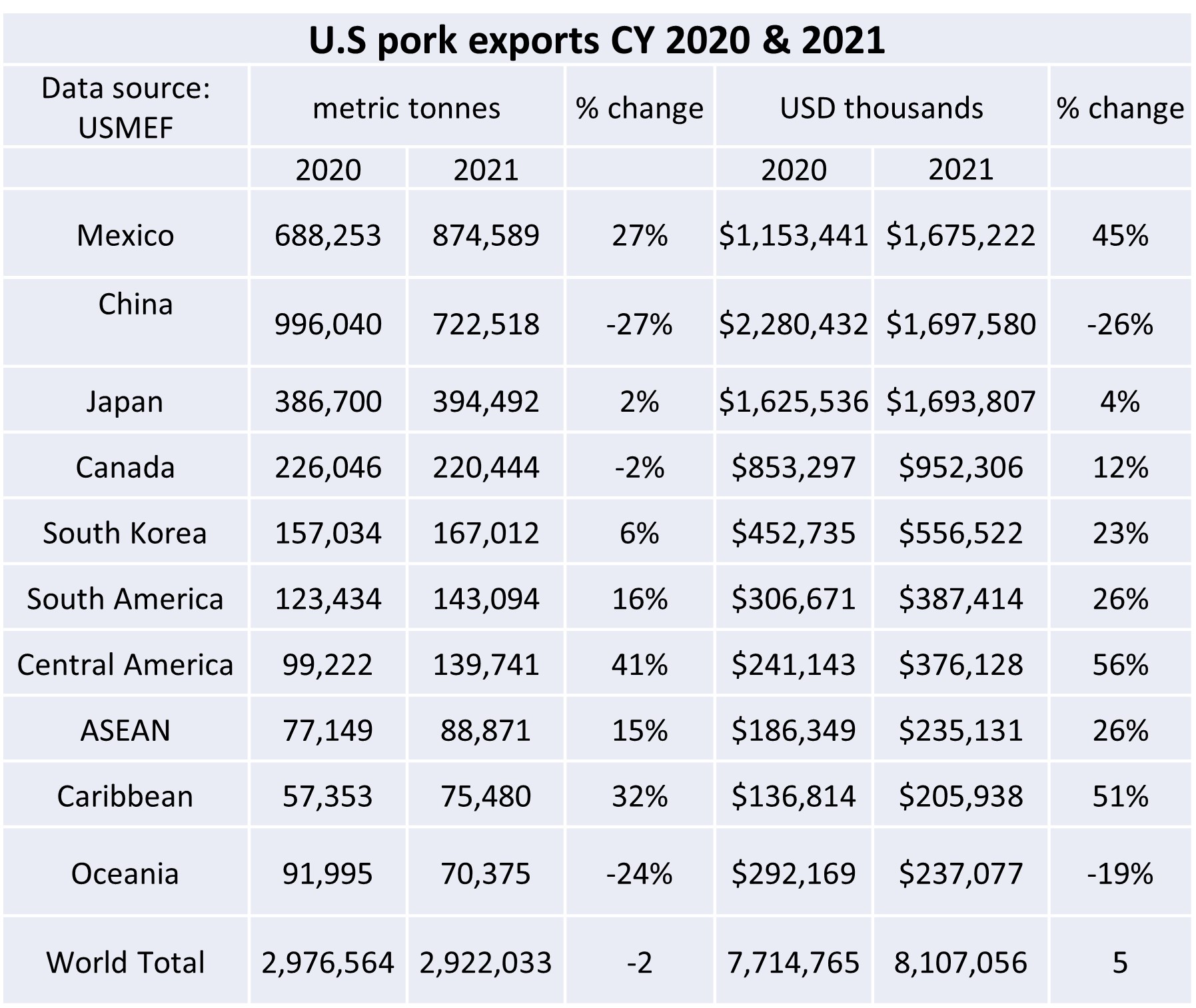New High for U.S. Pork Exports in 2021

Key market developments
The U.S pork exports performed extraordinarily well in what globally proved to be a challenging year for pork producers, as China picked up the pace in its sow herd rebuilding and pork production following the disruptions led on by ASF and Covid-19. Contrary to other major pork exporters, the U.S. are less dependent on the leading Chinese pork market meaning that despite declining U.S. exports to China, the sector experienced an overall growth of 5% YoY in 2021 data from USDA compiled by USMEF reveal. Shipment volumes to China fell 27% from 996,040 mt in 2020 to 722,518 mt in CY 2021, while the value of exports fell 26% from USD 2,28 billion to USD 1.70 billion.
The fall in exports to the Chinese market was largely offset by increased exports to Mexico, that along with a 27% growth in volume from 688,253 mt in 2020 to 874,589 mt in 2021, experienced a staggering 45% growth in value of exports from USD 1,15 billion to USD 1,68 billion. Similarly high growth rates were seen in Central America, where exports increased by 41% and 56% in terms of volume and value respectively, while exports to the Caribbean increased by 32% in volume and 51% in value. The drivers of growth in these two regions were Guatemala, Honduras and the Dominican Republic of which the latter’s domestic production was adversely affected by ASF. The 2021 export figures suggest that U.S growth in Central and South America is back on track after having suffered an 11% decrease in export volume in 2020 compared to 2019. Since 2011, the exported volume to Central and South America combined have increased 293% from 72,023 mt to 282,835 mt in 2021.

On the negative side, exports to the large markets of Hong Kong and Chile declined significantly in 2021. As China’s pork production picked up, Hong Kong was inevitably going to rely less on other import markets, meanwhiledata compiled by Pig333show that Chile chose to rely more on imports from Brazil and the EU that both gained market shares from the USA that saw their share of Chilean imports drop from 49% in 2020 to 22% in 2021.
Outlook on the future of the pork market
In 2021, U.S pork continued to penetrate the Mexican foodservice and retail markets, where pork has benefited from higher availability through takeout and delivery services, which diversify the use of U.S pork away from its primary use in food processing. According to USDA, Mexican imports are projected to increase 25,000 mt YoY in 2022 which could help continuing U.S growth on the market of their Southern neighbor as long as the depreciation of the Mexican peso and poor growth of the economy does not continue.
Globally, USDA projects a 117,000 mt drop in imports with China reducing imports by 200,000 mt and the Philippines by 85,000 mt as the country recovers from widespread ASF outbreaks. Contrary, Hong Kong is expected to increase imports by 35,000 mt, South Korea by 55,000 mt and Japan by 25,000 mt. U.S exports to Japan have rebounded since the U.S.-Japan Trade Agreement in 2020 gave way for lower tariffs and evened out the playing field with competing pork export nations. The unbeneficial tariff scheme had gradually lowered the U.S pork exports to Japan from 493,313 mt in 2011 to 369,891 mt in 2011, but the USDA remains hopeful that the tide has turned.